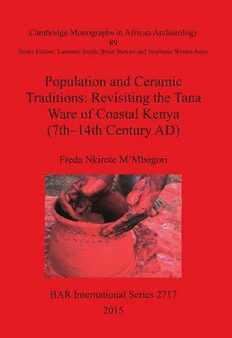
Population and Ceramic Traditions: Revisiting the Tana Ware of Coastal Kenya (7th-14th Century AD) PDF
159 Pages·2015·13.907 MB·English
Most books are stored in the elastic cloud where traffic is expensive. For this reason, we have a limit on daily download.
Preview Population and Ceramic Traditions: Revisiting the Tana Ware of Coastal Kenya (7th-14th Century AD)
Description:
This research is a departure from the traditional archaeological pottery analysis in Kenya, where emphasis has been on decorations and forms. It uses a technological approach to offer additional information on Bantu pottery. Pottery decorations and forms are still powerful instruments in defining the spatial and temporal distributions of prehistoric populations, but the ability of these attributes to mark social boundaries is limited by their obvious visibility on the finished product. Whilst this explicit visibility is an advantage for archaeologists who seek to explore temporal and spatial distributions of different wares, it is problematic, since it is possible for socially, ethnically, and linguistically distinct communities to copy from each other, making salient pottery features unreliable indicators of social boundaries. Therefore, this study emphasises the production stage, which is not as obvious on the finished product and must be learnt by apprenticeship only through kinship.This study sought to establish the social boundaries for makers of Tana ware; an Iron Age pottery attributed by some to Bantu speakers, whilst others attribute it to Cushitic speakers. Chaîne opératoire was used as an analytical tool for archaeological data collected from Manda and Ungwana site assemblages. Ethnographic reference data was collected from Cushitic and Bantu speakers from the Coastal and Highland regions of Kenya. Ethno-historical data was derived from library resources, while experimental data were obtained from the field.
See more
The list of books you might like
Most books are stored in the elastic cloud where traffic is expensive. For this reason, we have a limit on daily download.
